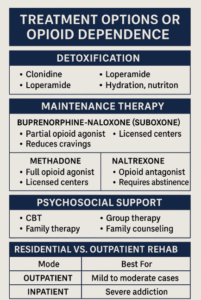Treatment Options for Opioid Dependence – From Detox to Maintenance
A practical guide to evidence-based recovery
🔍 Why You Need More Than Willpower
Opioid addiction isn’t a moral failing. It’s a medical condition.
And like all medical conditions, it has treatments—some of which can be lifesaving.
Unfortunately, many individuals with opioid use disorder (OUD) either receive no treatment or the wrong treatment, such as abrupt detox without follow-up, or punishment instead of therapy.
This article explores what actually works—from detoxification to medication-assisted treatment (MAT) to psychosocial interventions.

🧼 1. Detoxification – The First Step, Not the Solution
Detox involves managing acute withdrawal symptoms when stopping opioids.
Common Medications for Detox:
-
Clonidine: Reduces sympathetic symptoms like anxiety, tremors
-
Loperamide: For diarrhea
-
NSAIDs: For muscle aches
-
Hydration and nutrition: Crucial during this phase
📌 Important: Detox alone is not enough. Without follow-up, relapse rates are over 85% within weeks.
💊 2. Maintenance Therapy – Evidence-Based, Long-Term Recovery
✅ a. Buprenorphine-Naloxone (Suboxone)
-
Partial opioid agonist + antagonist
-
Reduces cravings and blocks the effect of other opioids
-
Can be prescribed in outpatient settings
-
Most preferred option in urban India
✅ b. Methadone
-
Full opioid agonist
-
Used for patients with high dependence levels
-
Requires daily supervised dosing at licensed centers
-
Rarely used in private clinics in India due to regulatory restrictions
✅ c. Naltrexone
-
Opioid antagonist (blocks receptors)
-
Used after full detox, requires complete abstinence
-
Best suited for highly motivated patients with good support systems
🧠 3. Psychosocial Support – The Other Half of Recovery
Medications work best with therapy.
Recommended Interventions:
-
CBT: Identify triggers, develop coping skills, prevent relapse
-
Motivational Interviewing: Enhances readiness to change
-
Group Therapy: Builds connection and accountability
-
Family Counseling: Heals relational damage and builds support
-
Peer support and recovery coaches
🏥 4. Residential vs. Outpatient Rehab – Which is Better?
| Mode | Best For | Duration |
|---|---|---|
| Outpatient | Mild to moderate cases, stable family | Weeks to months |
| Inpatient | Severe addiction, unstable homes, co-morbid psychiatric issues | 30–90 days |
📌 India has very few evidence-based residential programs. Choose wisely—look for centers that offer MAT, not just cold-turkey detox.
🧾 Cost, Access, and Stigma
-
Many effective medications (like buprenorphine) are affordable in generic form
-
Digital platforms now support tele-psychiatry and home-based recovery
-
But stigma, misinformation, and legal fears still delay help-seeking
📣 Takeaway
Opioid addiction isn’t cured by willpower—it’s managed by science, structure, and support.
Treatment is not one-size-fits-all. But doing nothing is the worst option.
In the next part of this series, we’ll break down the myths around opioid use, mental health, and recovery—and what conversations we need to start having.
👨⚕️ About the Author
Dr. Srinivas Rajkumar T, MBBS, MD (Psychiatry)
Consultant Psychiatrist | Apollo Clinics Velachery & Tambaram
Specialist in Addiction Medicine & Mental Health Reform
📞 For appointments: 85951 55808
🌐 More articles: www.srinivasaiims.com
📩 LinkedIn: Dr. Srinivas Rajkumar T